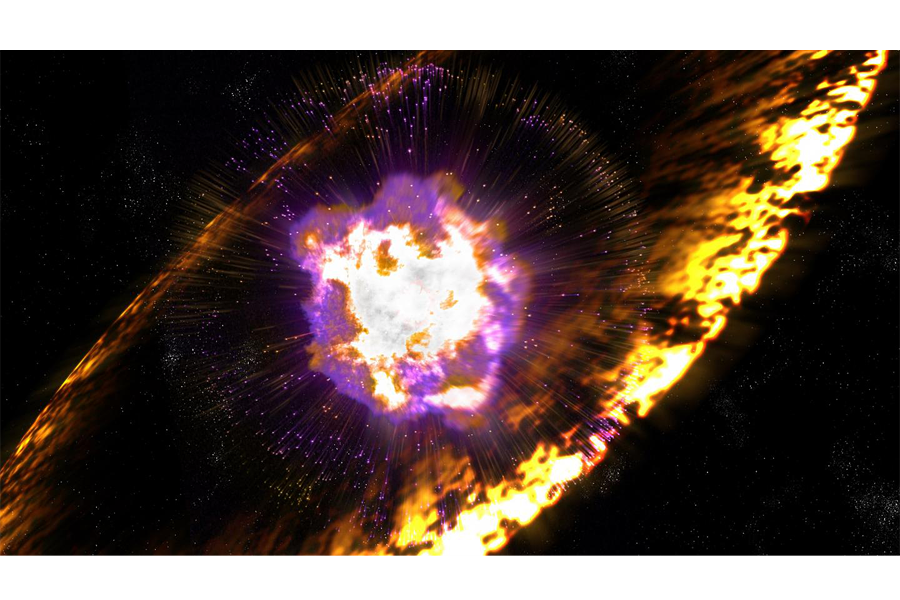Ancient supernovae showered radioactive iron on our planet, say astronomers
Loading...
When a dying star goes supernova, material sprays out into space. If this stellar burst of energy happens close enough, radioactive debris can rain down onto Earth.
This material could hold clues into mysteries of our own corner of space. So two research teams, in new studies both published Wednesday in the journal Nature, looked at deposits of the radioactive isotope iron-60 – essentially cosmic bread crumbs.
One team used the data in a model to determine when and where two recent, in cosmic terms, supernovae occurred. And their work could help unravel the mystery of the Local Bubble, a mass of hot gas that enshrouds our solar system.
The Local Bubble was identified decades ago, says Neil Gehrels, chief of the Astroparticle Physics Laboratory at NASA's Goddard Space Flight Center, who was not part of either new study. But "the origin of that bubble has been a mystery for a long time," he tells The Christian Science Monitor in an interview.
Scientists had speculated that supernovae produced such a massive gas bubble, Dr. Gehrels says. But this "is some of the really good first evidence of particular supernovae producing the local bubble."
Dieter Breitschwerdt, an astrophysicist at the Berlin Institute of Technology, led the research team that identified two supernovae that could have fed into the creation of the Local Bubble. One happened around 2.3 million years ago, while the other happened about 1.5 million years ago.
Both exploding stars were once members of a moving cluster of stars, a number of which likely went supernova. That cluster would have passed within 300 light years from Earth at the time that the two stars identified in this study exploded.
Dr. Breitschwerdt and colleagues spotted this cluster and modeled its trajectory in order to see if it fit with the timing of the iron-60 deposits and data linked to the Local Bubble. They turned the clock back on the star cluster and found that it was a match.
If they had been closer to the Earth, there would have been evidence of a much more damaging event, possibly even mass extinctions, at the time. But if it had been farther away, there wouldn't be as much iron-60. So the cluster's past trajectory fits right in the sweet-spot for the data.
"Either it's an incredible coincidence or it means that we are on the right track, we have found the right cluster and supernovae," Breitschwerdt tells the Monitor.
Breitschwerdt's paper used existing iron-60 data to identify and date the supernovae. But the other new Nature paper dug into ocean sediments, hunting for more.
"It does not exist naturally on Earth," Anton Wallner, a nuclear physicist at the Australian National University and lead author on the second paper, says of the radioactive material. "So if we find iron-60 on Earth, this would mean that it has to come from space somewhere."
Although meteorites that slam into the Earth can bring some iron-60, supernovae are the largest source, Dr. Wallner tells the Monitor in an interview.
The team took more than 100 samples from ocean floors across the globe, looking through layers of sediment in order to identify sections that contain iron-60.
For the sediments from between 1.5 and 3 million years ago, there was a strong signal of the radioactive substance, Wallner says. This is consistent with Breitschwerdt's findings as well.
But the researchers didn't stop there. They dug further and found evidence of an even more ancient supernova, between about 6.5 and 8 million years ago.
What impact could supernovae have on our planet?
Besides possibly creating the Local Bubble, supernovae can disrupt Earth systems depending on how close they are when they explode.
Most scientists agree that, at least for the kind of life found on Earth, supernovae typically have a "death radius," as Breitschwerdt calls it, of about 30 light years. Stellar explosions that close would bombard our planet with radiation so strong that it would destroy the ozone layer, allowing radiation to flow freely down onto the surface of the planet. Mass extinctions would ensue.
But that doesn't mean a supernova 300 light years away would have no effect.
A blast of particles from stellar explosions might also help seed cloud formation. Increased cloud cover could chill the planet, possibly even kicking off an ice age. Perhaps the most recent nearby supernovae identified in these new studies even contributed to the most recent ice ages on Earth.
Could a catastrophic supernova happen in the near future?
There are supernova going off all over the universe all the time, says Gehrels. But to see one in our corner of the universe is only likely to happen once to three times over a billion years, he says.
And, Wallner says, "There are no candidates for stars which could have a serious impact."






